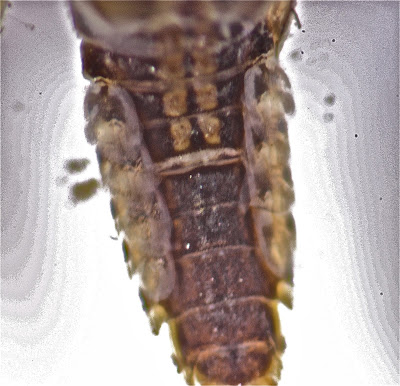Sunday, June 10, 2012
Beauty -- and the "Mystery" -- at the Rapidan River
I may as well start by saying I'm stymied by this spiny crawler mayfly I just found at the Rapidan River.
It's genus Serratella -- unless I'm missing something obvious: the caudal filaments have whorls of spines at the apex of each segment and lack intercalary hairs. But so far, I have not been able to determine the species, even with the help of Beaty's "Ephemeroptera of North Carolina." The big problem? Every species that he describes -- carolina, serrata, serratoides, and spiculosa -- has "submedian tubercles" on at least some of the terga. I can't see a one. Have a look.
So, the tails say it's Serratella; the tergites say it's Ephemerella. Hmmm??? I'll continue to work on this problem and hope to report back with a positive ID before very long. I'm probably overlooking something obvious. Anyway -- one more look at this colorful nymph.
Whatever the species, it's much prettier than the Serratella that I'm used to seeing locally in the summer -- this one, which is S. serratoides.
__________
Were it not for that spiny crawler, this is the taxon that would have been featured today. The "humpless" casemaker -- Brachycentridae, genus Brachycentrus.
There are now a lot of these cases attached to the rocks in the Rapidan river. The Brachycentrids "glue" the front lip of the case to the rocks, with the opening facing upstream. This is the casemaker that is lacking in "humps," so it has no way to generate a water flow through its case -- it has to rely on the natural current. So look for them on rocks in the riffles and rapids. The cases are 4-sided made of ribbons of bark, and most of the cases I see look pretty drab. Not those in the Rapidan River.
I see the greatest number of humpless cases in the summer -- at least in the Rapidan River -- which I find odd, since these are supposed to hatch in the spring (???). To fly fishermen, the adult Brachycentrid is known as "The American Grannom," and Thomas Ames (Caddisflies, p. 175) has the following to say on this hatch:
"The grannoms are among the first wave of caddisflies that appears on the mountain streams and tailwaters of the South in early March. Through April and May the crest moves up the Blue Ridge and through the Alleghenies on its way to the Catskill and Adirondack mountains and into the Berkshire hills. In northern New England Brachycentrus may be merely one of several caddisfly genera that hatch directly on the heels of the Hendrickson mayflies, but it is usually the dominant one."
I'd guess that the larvae I saw today would be hatching sometime in September, unless we've already got larvae from eggs that were laid back in the spring. But, for me, this is another mystery to solve.
_________
It was a good day for photos, so let's look at some of the beautiful insects I found in the river this morning.
1. Common stonefly: genus Perlesta. I saw a lot of them, but they were all on the small side, and the colors differ from those I've been seeing in Albemarle county. Probably an issue of species.
2. Small minnow mayfly: Baetis pluto. I love the colors on this one.
Identifying features of B. pluto include the fact that tergite 5 is pale while 6 and 7 are dark, and the pale lines next to the eyes that make the head looks like it's striped.
3. Small minnow mayflies: Acentrella turbida. I found several; all had black wing pads and appeared to be ready to hatch. (The two below were both females.)
4. And I still found some E. dorothea spiny crawlers up here, including one with colors I've not seen before. I thought it might be E. invaria, but it did not have the requisite tubercles on the abdominal segments.
And the more common E. dorothea.
Another nice day spent in Madison County.
Subscribe to:
Post Comments (Atom)




















No comments:
Post a Comment